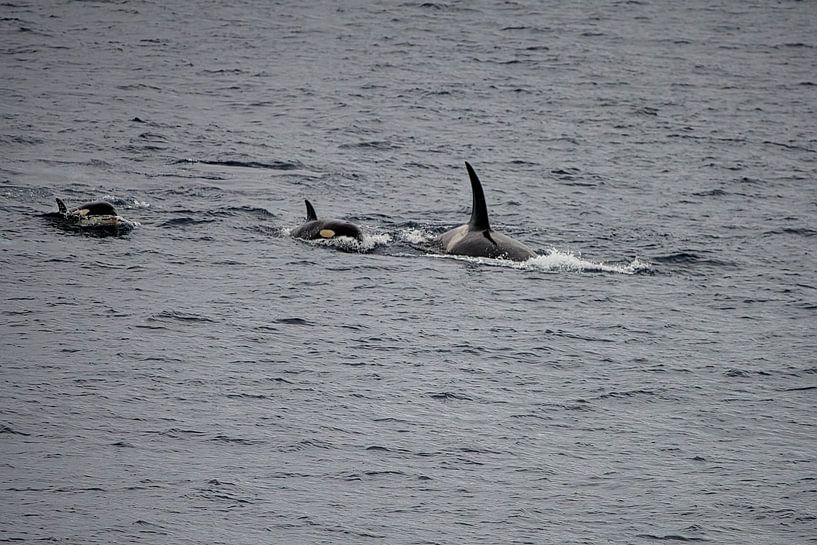Buy the photo Orca with offspring by Kai Müller on canvas, ArtFrame, poster and wallpaper, printed on demand in high quality.
About "Orca with offspring"
by Kai Müller
About the artwork
The orca is one of the best-known whales of all and is one of the most agile predators in the animal kingdom.
Characteristics
Body length: females: 5 - 8 m, males: 6 - 10 m
Weight: 4-7 t
Life expectancy: 25 - 60 years (males) 40 - 90 years (females)
Distribution: worldwide
Habitat: oceans
Species population: insufficient data
systematics
Class: Mammals
Order: whales
Suborder: toothed whales
Family: Dolphins
Genus: Orcinus
Species: Killer Whale (Orcinus orca)
appearance of the killer whale
The killer whale belongs to the toothed whales and is the largest representative of the dolphin family. Males can grow up to 10 meters long and weigh 6.6 tons. Females are significantly smaller and lighter.
The killer whale owes its name to its large dorsal fin (fin). It is slightly curved backwards in females, while it is straight or pointed forward in males. On average, it is about 60 centimeters long, but in some males it can grow up to 1.8 meters.
The pectoral fins of the orca can be up to two meters long and are very rounded. The caudal fin is horizontal and slightly forked. The killer whale's mighty head tapers to a point at the snout.
The body is mostly black, the belly, throat and underside of the caudal fin are bright white. There is also a white spot above each killer whale's eyes.
reproduction and development
The mating season of killer whales varies by region. In the North Atlantic, the animals mate between November and January, in the North Pacific between May and June.
Female orcas typically have between five and six calves in their lifetime, roughly between the ages of 12 and 40. They usually become sexually mature at around eight years of age, males at 13.
After a gestation period of 12 to 18 months, female killer whales give birth to one young. The young animal is already fully developed at birth. It weighs around 170 kilograms and is a good two meters long. The mother nurses her offspring for about a year. The bond between calf and mother is very close. The young animals learn from the adult orcas, for example how to hunt. This is how special skills and strategies are passed on from generation to generation.
Mortality is very high in young killer whales. Adult orcas, on the other hand, have no predators and therefore have a low mortality rate.
lifestyle and behavior
All killer whales are very sociable and social. They live together in groups called schools or pods. Such a group can consist of up

About Kai Müller
For as long as I can remember I have always been drawn to the beauty of the environment and the wild spirit of wildlife. However, my love for nature and wildlife photography began a few years back after a series of travels coupled with my studies in design. .. Read more…
 Netherlands
Netherlands Ordered in November 2021
Ordered in November 2021
 Germany
Germany Ordered in March 2019
Ordered in March 2019
 Netherlands
Netherlands Ordered in August 2021
Ordered in August 2021
 Netherlands
Netherlands Ordered in September 2019
Ordered in September 2019
 Germany
Germany Ordered in March 2024
Ordered in March 2024
 Germany
Germany Ordered in September 2020
Ordered in September 2020
 Germany
Germany Ordered in September 2022
Ordered in September 2022
 Netherlands
Netherlands Ordered in January 2025
Ordered in January 2025
 Netherlands
Netherlands Ordered in August 2022
Ordered in August 2022
 Netherlands
Netherlands Ordered in March 2020
Ordered in March 2020
 Germany
Germany Ordered in October 2019
Ordered in October 2019
 Germany
Germany Ordered in September 2020
Ordered in September 2020
About the material
ArtFrame™
Interchangeable Art Prints
- High-quality print
- Easily interchangeable
- Acoustic function
- Large sizes available
Discover the artworks of Kai Müller
 Reindeer herd in Pasvik National ParkKai Müller
Reindeer herd in Pasvik National ParkKai Müller Northern Lights Panorama LofotenKai Müller
Northern Lights Panorama LofotenKai Müller Polar FoxKai Müller
Polar FoxKai Müller AgardhbuktaKai Müller
AgardhbuktaKai Müller Longyearbyen photographed from the mountain SarkofagenKai Müller
Longyearbyen photographed from the mountain SarkofagenKai Müller Hiorthamn SvalbardKai Müller
Hiorthamn SvalbardKai Müller Pack ice in the AsgardbuktaKai Müller
Pack ice in the AsgardbuktaKai Müller Reindeer herd in Pasvik National ParkKai Müller
Reindeer herd in Pasvik National ParkKai Müller Uttakleiv on the Lofoten under the northern lightsKai Müller
Uttakleiv on the Lofoten under the northern lightsKai Müller Aurora Borealis before the mountainsKai Müller
Aurora Borealis before the mountainsKai Müller WhalersKai Müller
WhalersKai Müller Reine LofotenKai Müller
Reine LofotenKai Müller Reindeer in Pasvik National ParkKai Müller
Reindeer in Pasvik National ParkKai Müller Pasvik National ParkKai Müller
Pasvik National ParkKai Müller Vardø ArtKai Müller
Vardø ArtKai Müller Northern lights over the lighthouse of SlettnesKai Müller
Northern lights over the lighthouse of SlettnesKai Müller Sommarøy in the winter evening lightKai Müller
Sommarøy in the winter evening lightKai Müller Giant Iceberg Antarctic PeninsulaKai Müller
Giant Iceberg Antarctic PeninsulaKai Müller HallingskeidKai Müller
HallingskeidKai Müller Lofoten ReineKai Müller
Lofoten ReineKai Müller













 Dolphin
Dolphin Photo wallpaper
Photo wallpaper Photography
Photography Sea animals
Sea animals Serene Peace
Serene Peace Whales and orcas
Whales and orcas









